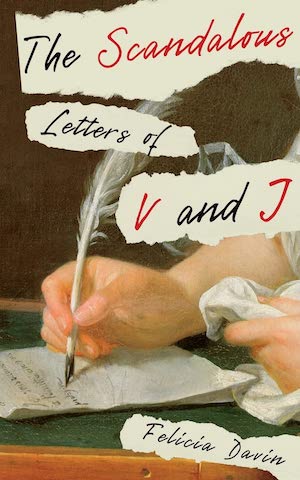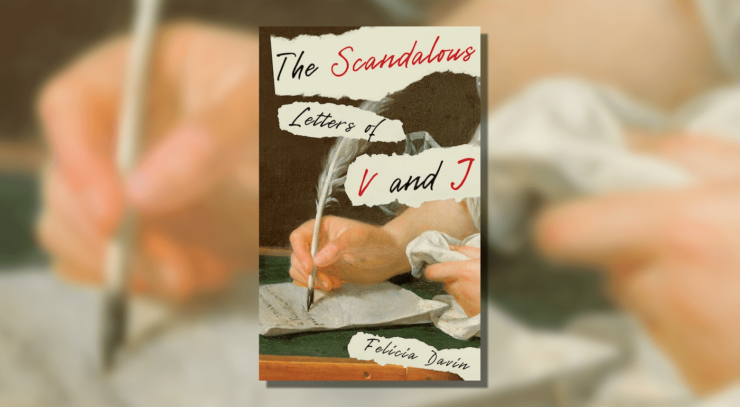Julie/n, one of the two leads in Felicia Davin’s new epistolary romance The Scandalous Letters of V and J, writes to their sister:
How did you know when you’d finished your work, Adrienne? I know you are going to write “it felt right.” That’s how it feels to finish a drawing or a painting, and I imagine it’s like that. And I’ve finished a lot of drawings and paintings, but I don’t think I’ve finished myself.
Maybe that’s me, though. What I like best is the work in progress. I’m not interested in taking the canvas off the easel and framing it.
I found this quite sweet as a metaphor for the project of being human, but I soon realized that Julien is being more literal. They, and Adrienne, and everyone in their family, have the power to alter reality through art.
If Julien decides they want to grow facial hair, or change the angles of their face, or try out a different configuration of sex organs, they can use magic to draw or paint themselves that way, and lo, it is so. (They can use magic and art to affect reality in other ways, too, but they elect not to, for ethical reasons.) Their physical form is as fluid as their gender identity, and it’s a site of novelty, caprice, and delight.
The Scandalous Letters of V and J, currently being delivered in email installments (subscribe here! There’s an archive where you can catch up on the story so far!) and to be published in its entirety in mid-May, is tender and weird and features sinister rich people trying to use magic for The Wrong Reasons while our heroes do their best to thwart them.
Though the book features two nonbinary protagonists living in nineteenth century Paris, their sexuality and gender identities are virtually a non-issue. Davin weaves together real and imagined queer history, including a character inspired by George Sand by way of Balzac, a move that unfussily reminds the reader that queer people have always been here no matter how their names and stories have been obfuscated. Julie (who variously goes by Julie and Julien and uses different pronouns on different days) possesses magic that allows them to look however they want to look; they come from an unfailingly loving and supporting family. Victor, not long after deciding to ditch his original name and gender, accidentally magics his horrible father and brother into accepting his new name, which eliminates the last potential source of gender conflict.
The Scandalous Letters of V and J is, not coincidentally, an indie romance.
If I sound the teensiest bit salty, it’s because traditionally published romance has long been a site for enforcing the gender binary and patriarchal gender norms more broadly. An early-aughts attempt to officially define romance had to fend off a proposal to include the phrase “between a man and a woman.” Even quite casual readers of romance are probably familiar with the way romance novel characters have this supernatural ability to smell, taste, hear, and see gender. Here’s a few examples of what I’m talking about:
- “every breath she took was him: pure male, musky, spicy, sweaty, and more”
- “it’s that super masculine type of shout”
- “the faintest hint of some spicy male fragrance”
- (imagining the daughter of a male character known to the narrator) “[his] aristocratically masculine features made softer and more rounded”
- “the words were strong and somehow soft and lilting and beautifully feminine”
These excerpts all come from romance novels I read in 2022; all of them are from books and authors I enjoy. The books are by white authors and authors of color; they’re het and they’re queer (though queer romance tends to be slightly better about this overall); they’re historical and contemporary and paranormal. This doesn’t even get into the gendering of bodies, a problem equally endemic to romance but harder to term-search, where all men have hard things like pectoral muscles and straining dicks and all women have soft things like pillowy breasts and plump, half-parted lips. It’s the finest in gender essentialism, served up hot in every third romance novel you come across. I am extremely tired of it. By contrast, here’s Victor looking at a drawing J has done of him:
At first glance, it is a study of a young man’s head. A few short blond curls brush his forehead, and the rest of his hair brushes the tops of his ears. He has a straight, slender nose and a sharp jaw, but there is youthful softness in his smooth cheeks. And at second glance one begins to wonder: is this a young man? Perhaps the jaw is not sharp, but delicate. Look at the indulgent curve of the bottom lip, at the luxuriant lashes. But the hair is short and the neck is clothed in a cravat. Some young men do have an androgynous quality. It is not unheard of for men to have thick lashes and soft mouths. The question lingers. It invites further study. After long looking, one discards the question in favor of others: what secret joy motivates that little smile? What knowledge lifts the arch of that brow? Is there an offer in this expression, or only mockery?
It’s a refreshing—and pointed—description, reminding the reader that gender is neither fixed nor objectively perceptible. Someone who looked at Victor’s portrait expecting to see a man would see a sharp jaw and not a delicate one, not because of any quality in the jaw or in Victor, but because our perceptions of reality shape and are shaped by the language we use to describe them. Victor and Julien have many reasons to like each other, but one of the big ones is their growing certainty that they’ll each be seen for who they actually are, rather than in one of a narrow range of roles society has prescribed to them.
In the first third of the book, Julie and Victor are very sweetly feeling each other out, while Julie attends art school (she’s better at art than all these other jokers) and Victor starts to discover that the world contains magic and maybe they can personally do some. Each of them worries now and then that the other one doesn’t like them, but they’re confident at least in being found attractive. When they have sex, they’re curious and considerate of each other, and indelibly attracted to each other without getting particularly hung up on which body part goes where and does what. The conflict that eventually arises between them, keeping them apart for a good chunk of the book, has nothing to do with bodies or sexuality or gender, but rather is an ethical disconnect. By that I mean that one of them wants to maybe do quite a lot of magic art crime and the other one is like, whoa whoa, let’s cool our jets, idk if we should get involved with doing so much magic art crime.
None of this is to suggest that gender doesn’t matter in the book. Both protagonists surround themselves with queer community and gender affirmation, and Victor checks in with Julie regularly about their preferred name and pronouns for any given day. But bodies and identity are never a space for trauma in this book—only for joy, attraction, experimentation, and play. Within their sexual and romantic relationship, Victor and Julien are perpetually trying on different roles, different acts, even different bodily configurations, unfettered by the constraints of what’s allowable to a person of this or that gender.
As the book goes on, Victor gets drawn more deeply into the world of magic, where he finds a queer and magical community to help him learn how to wield his newfound power. Julie wants none of it, having had a youthful run-in with an unscrupulous magician who left her fearful of magic-users outside her own immediate family. As she has occasion to know, there exists a faction of people (men) (rich ones) who wield magic to enrich themselves and control others, particularly those who attempt to step outside of their societally prescribed roles. Fighting against the unethical use of magic turns out to go hand in hand with resisting the stultifying control of the heteropatriarchy.
Buy the Book


The Scandalous Letters of V and J
If you had asked me which genre—the one designed to imagine new worlds and futures, or the one designed to reputation-launder heterosexuality for the Betty Friedan generation—would have had greater success at dreaming past the gender binary, I’d of course have said SFF. And I wouldn’t be wrong (my chaos angel Jadzia Dax is on my television screen as I write this), but I wouldn’t be right by nearly as wide a margin as one might expect. Sure, traditionally published romance has been agonizingly slow to offer space to nonbinary protagonists. On the SFF side, for every Nona the Ninth, with its casual refusal to align bodies and gender identity, there’s like seventy billion gender essentialist dystopias (The Power, Y: The Last Man, The Men, Red Clocks, Afterland, I am not even having to try hard to come up with these).
The last few years have seen a blossoming of SFF books that feature trans and nonbinary characters, are set in so-called queernorm worlds, and play with ideas of binary gender. Both SFF proper and literary fiction with SFF cooties have begun to make space for a range of gender identities and sexualities. Neon Yang’s Tensorate series and Yoon Ha Lee’s excellent, overlooked Phoenix Extravagant both feature nonbinary protagonists and worlds unreliant on binary gender, while books like River Solomons’ Sorrowland and Isaac Fellman’s Dead Collections include explicit sex scenes among queer, nonbinary, intersex, and trans characters. But it’s still weirdly rare to find books where nonbinary characters get to just have fun during sex.
Victor and Julien are an exception. The Scandalous Letters of V and J marries the unfussiness of the queernorm SFF world to the sexual frankness of romance, and it’s refreshingly non-gloomy about it to boot. Julien and Victor approach sex with a joy that’s unfettered by gendered assumptions about what their bodies should look like, or what kind of sex they should want. Rather, they take a yes-and approach to sex that allows them to experiment with positions, fantasies, body parts, props, and anything else their hearts desire.
The Scandalous Letters of V and J is funny and sweet and tender, shot through with the author’s love for Balzac’s France, and it’s wicked fun to receive in daily installments. More than that, though, it’s one of those indie books that can point a way forward for how we tell stories about love, bodies, and sex. Though V and J is set in the past, its characters buck the restraints of their own period’s conceptions of gender, and—crucially—of ours, as well. As Republican legislatures across the country pass ramp up attempts to hound trans, nonbinary, and gender-nonconforming people out of public life, we need stories like this one, dreaming beyond our limiting historical conceptions of gender and reminding us of the joy that lies on the other side.
Jenny Hamilton reads the end before she reads the middle. She reviews for Strange Horizons and Lady Business and can be found at her website or on Twitter @readingtheend.










